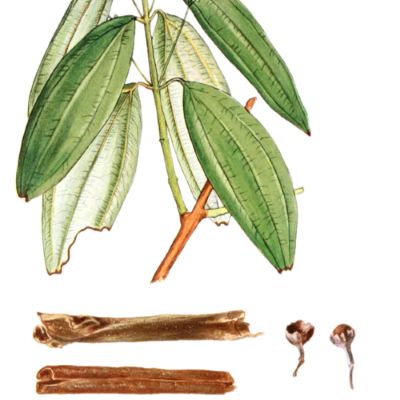Ceylon Cinnamon
Ceylon Cinnamon
Cinnamomum verum J.Presl
Lauraceae Family
Description of Cinnamon
Ceylon cinnamon is an evergreen tropical tree 10–15 m tall. The root system is branched, penetrating to a depth of 1–2 m. The trunk bark is thin, gray-brown. Leaves are oval, leathery, 7–18 cm long, shiny, dark green on top, light below, with three prominent veins. Flowers are small, greenish-yellow, gathered in panicle inflorescences. Fruits are small purple berries, 1–1.5 cm, rarely used. The main raw material is the inner bark of young shoots, removed in thin layers and rolled into tubes (cinnamon sticks). Flowering in January–March, bark harvesting in the rainy season (May–November). Propagated by seeds or cuttings. Varieties: ‘True Ceylon’, ‘Sri Gemunu’, ‘Sri Wijaya’.
Distribution and Ecology of Cinnamon
Ceylon cinnamon originates from Sri Lanka, cultivated in tropical regions (Sri Lanka, India, Seychelles, Madagascar). Prefers humid, well-drained soils (pH 5.5–6.5), partial shade or diffused light, high humidity. Optimal growth temperature 20–30 °C, does not tolerate frosts. Bark yield: 100–200 kg/ha. Care: watering (15–20 L/m² every 5–7 days), feeding with organic fertilizers (20–30 kg/tree), protection from fungal diseases and bark beetles. Propagated by seeds (sowing in rainy season) or cuttings (spring). Ecologically enriches the soil, but monocultures deplete the ground. Can be invasive in tropics if uncontrolled.
Raw Materials from Cinnamon
Raw materials: bark (sticks or powder), essential oil, rarely leaves. Bark is harvested in rainy season (May–November) from 2–3-year-old shoots, dried at 30–35 °C to brown color (yield 15–20%). Essential oil is extracted by steam distillation from bark (yield 1–2%) or leaves (0.5–1%). Leaves harvested year-round, dried in shade (yield 10–15%). Quality: bark light brown, moisture <12%, essential oil ≥1%, organic/mineral impurities ≤0.5%, total ash ≤5%; oil clear, yellowish; leaves no darkening. Store bark and leaves in airtight containers (2–3 years), oil in dark glass bottles (2 years). Bark and oil aroma warm, spicy; bark taste sweet-burning.
Chemical Composition of Cinnamon
Bark: essential oil (1–4%, cinnamaldehyde 60–80%, eugenol, linalool), tannins (5–10%), polyphenols, coumarins (0.01–0.05%), carbohydrates (20–30%), minerals (potassium, calcium, magnesium). Essential oil: cinnamaldehyde (main component), eugenol, cinnamyl acetate. Leaves: essential oil (0.5–1%, eugenol 70–80%), flavonoids, tannins. Calorie content of bark: 240–260 kcal/100 g.
Effects and Applications of Cinnamon
Cinnamon has antiseptic, anti-inflammatory, antioxidant, antispasmodic, and hypoglycemic effects due to cinnamaldehyde, polyphenols, and eugenol. Bark is used for colds, digestive disorders (flatulence, diarrhea), diabetes (to lower blood sugar), to improve circulation. Essential oil is used in aromatherapy to relieve stress, improve concentration, and in inhalations for bronchitis. Leaf infusions have anti-inflammatory and mild antiseptic effects, used for skin irritations. In cosmetology, cinnamon improves skin circulation, stimulates hair growth. Externally, oil is used for massage in muscle pains.
Precautions for Using Cinnamon
Bark in large quantities (>5 g/day) or essential oil (>2 ml/day internally, undiluted externally) may cause stomach irritation, allergic reactions, or toxicity due to coumarins. Prolonged use (more than 1 month) may affect liver function. Store bark at humidity <12% to prevent mold. Give children under 3 years infusions in doses ≤5 ml/day. Do not combine with drugs affecting blood clotting or blood sugar without doctor's consultation. Avoid oil on sensitive skin without dilution.
Contraindications for Using Cinnamon
Cinnamon is contraindicated in allergies to Lauraceae, peptic ulcers, gastritis with high acidity, liver diseases, pregnancy, lactation, children under 1 year. External use of essential oil is prohibited in eczema, psoriasis, or open wounds.
Recipes with Cinnamon
- Cinnamon Tea for Colds. Pour 2 g ground bark with 200 ml boiling water, infuse 10 min, add honey, drink 2 times a day, 7 days.
- Leaf Infusion for Dermatitis. Pour 10 g leaves with 200 ml boiling water, infuse 30 min, wipe skin 2 times a day, 7 days.
- Inhalation for Bronchitis. Add 3 drops essential oil to 1 L hot water, breathe steam 10 min, 1 time a day, 5 days.
- Bark Infusion for Diabetes. Pour 2 g bark with 200 ml boiling water, infuse 20 min, drink 50 ml 2 times a day, 10 days.
- Massage Oil for Pains. Mix 5 ml cinnamon essential oil with 20 ml olive oil, massage muscles, 1 time a day, 5 days.
Cosmetics from Cinnamon
Cinnamon bark and essential oil are used in cosmetology due to antiseptic, antioxidant, and circulation-improving properties, enhance skin and hair condition.
- Face Mask. Mix 2 g ground bark with 10 g honey, apply to face for 10 min, rinse. Use 1 time a week.
- Body Scrub. Mix 5 g ground bark with 10 ml coconut oil, massage skin 5 min, rinse. Use 1 time a week.
- Hair Massage Oil. Mix 3 ml cinnamon essential oil with 20 ml almond oil, apply to hair roots, rinse after 20 min, 1 time a week.
- Skin Toner. Infuse 2 g bark in 200 ml boiling water 20 min, wipe face 1 time a day, 7 days.
Culinary Uses of Cinnamon
Cinnamon bark is used as a spice in baking, desserts, drinks, meat dishes. Powder or sticks added for aroma. Store bark at 0–5 °C in airtight container up to 3 years. Varieties: ‘True Ceylon’ (for desserts), ‘Sri Wijaya’ (for drinks).
- Mulled Wine with Cinnamon. Add 1 cinnamon stick to 500 ml red wine with 50 g sugar, heat to 70 °C, infuse 10 min.
- Cinnamon Cookies. Add 2 g ground cinnamon to dough (200 g flour, 100 g sugar, 100 g butter), bake at 180 °C 15 min.
- Rice with Cinnamon. Add 2 g ground cinnamon to 200 g cooked rice with 20 g raisins, serve warm.
- Cinnamon Tea. Pour 1 g ground bark with 200 ml boiling water, infuse 10 min, add honey, serve warm.
Other Properties of Cinnamon
Cinnamon is used in perfumery, pharmaceuticals (antiseptic preparations). Essential oil used as insect repellent. Ornamental plant for tropical gardens. Bark used in aromatherapy and as natural flavoring.




